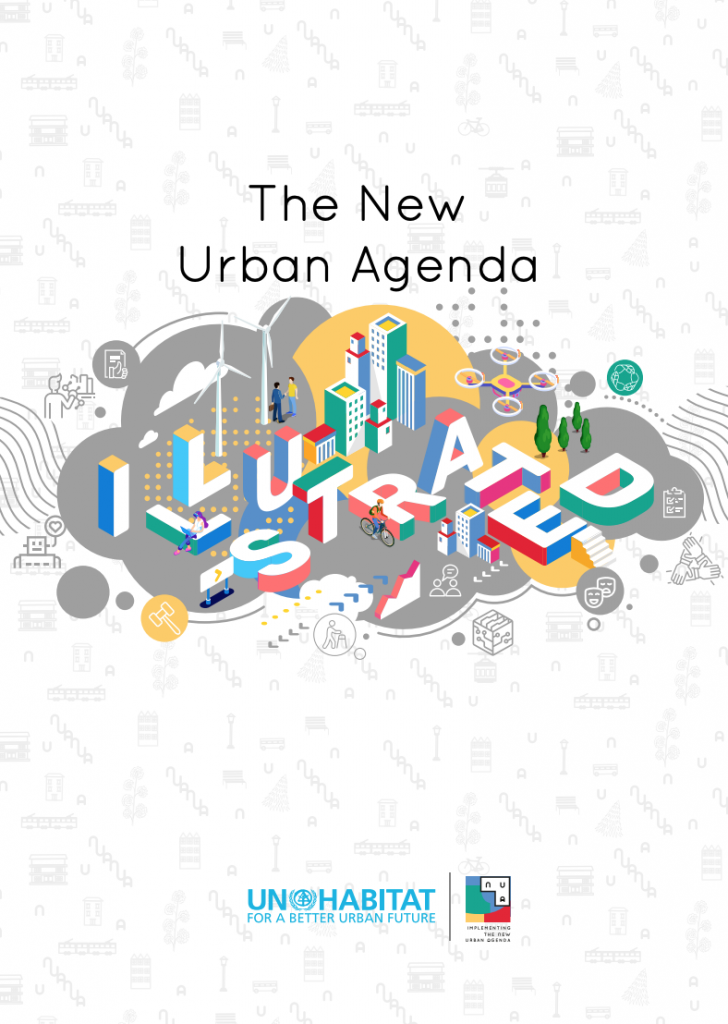The United Nations Human Settlements Programme (UN-Habitat) has launched The New Urban Agenda Illustrated, an engaging handbook to accelerate progress towards the Sustainable Development Goals (SDGs), particularly SDG 11 – Make cities and human settlements inclusive, safe, resilient and sustainable.
Into the New Urban Agenda (NUA), the illustrated guide breathes colour, clarity and, through the provision of best practices, a welcome dose of pragmatism.
In case you haven’t heard of it, the NUA is a 48-page blueprint and roadmap for achieving sustainable urban development. It was adopted at the United Nations Conference on Housing and Sustainable Urban Development (Habitat III) in Quito, October 2016, and endorsed two months later by the United Nations General Assembly at its 68th plenary meeting of the 71st session. The NUA articulates the commitments of world leaders to provide basic services for all, ensure equality of opportunity, strengthen urban resilience, take climate action, respect human rights, improve connectivity, and promote safe, accessible and green public spaces.
Albeit pregnant with ideas and audacious with ambition, the NUA in its original form was found wanting in terms of accessibility, poetic charm and real-life examples. The illustrative guide, however, adeptly addresses these limitations. It gives greater sense, structure and substance to the issues, challenges and solutions laid out in the NUA while forging neat alignment with the SDGs.

Nature in the New Urban Agenda
The imperative to create greener, healthier and wilder cities was not lost on the authors of the NUA, nor of the illustrated handbook. The NUA envisions cities that (13(h)) “protect, conserve, restore and promote their ecosystems, water, natural habitats and biodiversity” while minimising their environmental impact. More specifically, it sets out a number of “transformative commitments” pertaining directly to biodiversity and ecosystem services:
- (37) the promotion of safe, inclusive, accessible, green, multifunctional and quality public spaces;
- (65) the sustainable management of natural resources in cities in a manner that protects and improves the urban ecosystem and ecosystem services (i.e. natural capital stocks and flows);
- (67) the creation and maintenance of well-connected and well-distributed networks of public greenspace, improvement of ambient air quality, and conservation of endemic species;
- (68) the special treatment of urban deltas, coastal areas and other environmentally sensitive areas;
- (69) the preservation and promotion of the ecological function of land, the use of nature-based solutions, the avoidance of exceeding regenerative capacities of ecosystems, the sustainable use of land, the containment of urban sprawl, and the prevention of losing fragile and important ecosystems;
- (71) the strengthening of sustainable management of resources including land, water (oceans, seas and freshwater), and forests; the minimisation of air and short-lived climate pollutants, greenhouse gases and noise; and the facilitation of conservation, regeneration, restoration and resilience of ecosystems;
- (100) the provision of well-designed networks of green streets and other public spaces;
- (101) the integration of climate change considerations and nature-based solutions into territorial development and planning processes, and the design of spaces, buildings and infrastructure;
- (157) the provision of support to science, research and innovation including nature-based innovation; the sharing of information, knowledge and expertise; and the collection, analysis, standardization and dissemination of geographically based, community-collected, high-quality, timely and reliable data;
- (158) the strengthening of data and statistical capacities at all levels of government to effectively monitor progress in achieving sustainable urban development using official and other data sources, in a transparent and consistent manner;
- (159) the involvement of governments at all levels in data collection, mapping, analysis and dissemination, and the promotion of evidence-based governance; and
- (160) the fostering of open, user-friendly and participatory data platforms using technological and social tools.
If you recognise the importance of the above list but prefer to take your transformative commitments with a dollop of sugar, spice and logic, then visit section 1.3.1 of the illustrated guide. It will be right up your alley!
